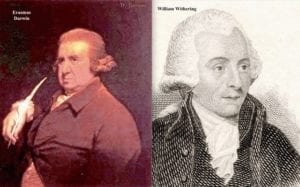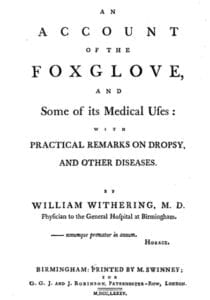JMS Pearce
Hull, England, United Kingdom
“’Precursoritis’ is the bane of historiography.”
– Stephen Jay Gould

Fig 1. Erasmus Darwin and William Withering
One of the best-known and important discoveries in the practice of medicine was the introduction of digitalis by William Withering (Fig 1). It was the subject of controversy that involved the Darwin family. For almost two hundred years digitalis was the mainstay of treatment for “dropsy,” congestive cardiac failure, and atrial fibrillation.1
Digitalis had been known and used since classic descriptions were given by both Dioscorides and Galen (respectively first and second centuries AD). Withering’s colleague, Dr. John Ash, had used it for pulmonary edema. Withering’s famous text, An Account of the foxglove, and some of its medical uses, was published in Birmingham in 1785 (Fig 2) and established with precision its clinical effects and toxicity.2 Withering, one of England’s most eminent botanists, had treated 163 cases and showed the efficacy of the foxglove in treating dropsy.3 He noted that it was effective in small doses and worked best if dried leaves were picked just before the plant blossomed (Fig 3).
Leonhard Fuchs (1501-1566), who first showed its diuretic effects, first recorded the name “foxglove” from Latin digitus—finger. The Anglo-Saxon Foxes-glees or “fox music” refers to an old musical instrument with bells, resembling the flowers hung on an arched support.
Considerable argument developed with Erasmus Darwin MD, FRS (1731–1802), a brilliantly creative naturalist, physician, poet, and Withering’s fellow Lunar Society member, who claimed priority for the foxglove’s therapeutic use in dropsy.4,5,6 Erasmus Darwin was an eccentric, larger than life figure7 whom the poet Coleridge described as possessing perhaps a greater range of knowledge than any other man in Europe. Erasmus had befriended Withering, helping him to join the Lunar Society, and aided his appointment as physician to Birmingham General Hospital, and a practice that was extremely lucrative. But Erasmus Darwin disputed Withering’s priority. His claim related to Charles Darwin, his eldest son. Charles was born September 3, 1758, in Lichfield, brother of Erasmus Jr. Robert Waring Darwin FRS, born in 1766, who was father of Charles Robert Darwin, author of The Origin of Species.

Charles attended Lichfield school and went onto Christ Church College, Oxford where he matriculated aged sixteen in March 1775. He spent nearly a year at Christ Church, but chose to read medicine in Edinburgh where he remained until his premature death on 15 May 1778. He became friends with Andrew Duncan, a young physician (who later took the Chair in The Theory of Medicine) in whose house he lived and gained from his guidance and access to the wards of the Edinburgh Royal Infirmary.
He graduated in 1778 and won the Aesculapian Society gold medal for a thesis that distinguished the characteristics of mucus and pus. In the same year, aged only twenty, a fatal illness was to cut short his promising career. Another manuscript of sixty-seven pages entitled “What are the established varieties of the pulse, their causes & uses in medicine” was later discovered unpublished at the Medical Society of London. Charles in his brief life showed precocious intellectual achievements, full of promise.
Claims for priority
The eminent Oxford neurophysiologist JF Fulton stated that the evidence is overwhelmingly in favor of dropsy treated by the foxglove having been appended to Charles’s thesis by his father Erasmus.4 Erasmus translated Charles’s graduating dissertation from Latin into English, and had it together with the gold medal winning dissertation published in Lichfield as a book in 1780 as Experiments establishing a criterion between mucaginous and purulent matter. The author’s name was shown as Charles Darwin, and Erasmus wrote a short memoir as an appendix. In Charles Darwin’s text is a description of the therapeutic effects of the decoction of foxglove. Nine case histories are given, appended rather casually on pages 103-112 after the following heading: “A note belonging to page 65, and 68.” Fulton observed: one would naturally infer that they were cases seen and described by Charles himself, for there is nothing, except their position in the text, to suggest that his father inserted them. The case reports are, however, prefaced by:
“The foxglove has been given to dropsical patients in this country with considerable success: the following cases are related with design to ascertain the particular kinds of dropsy, in which this drug is preferable to squill, or other evacuants.” The case-reports are important since they contain the first accurate description of the therapeutic effect of digitalis in cardiac edema published in any language, antedating Withering’s celebrated book, An account of the foxglove, by five years.
Erasmus Darwin made no mention of Withering’s work when in 1785 he reported:
In a pamphlet entitled ‘Experiments establishing a criterion between mucaginous and purulent matter, with an account of the retrograde motions of the absorbent vessels’, printed for Cadell, 1780, I subjoined [in 1780] about half a dozen cases of dropsies treated successfully by the decoction of digitalis; and endeavored to distinguish the species of dropsies, in which it would generally succeed. To that account I could now add at least a score of other cases, cured by the same method. . . .8
The “pamphlet” must refer to Charles’s thesis.
Withering recorded that Erasmus Darwin first became acquainted with the action of digitalis on the 25th of July 1776 when seeing a Miss Hill of Aston in consultation with himself. Priority of publication therefore rests with the somewhat testy Erasmus Darwin, whose experience was plainly passed onto his son Charles, who is mentioned briefly in Withering’s book.
However it was Withering’s more systematic experiments and observations reflecting ten years’ practice and particularly his caution relating dose to toxicity that led to the widespread use of digitalis. Withering assiduously chronicled his preparation of the leaves of the purple foxglove (Digitalis purpurea).9,10 (Fig 2) He showed that some patients were more sensitive than others, and observed slowing of the heart, diuresis, and side effects such as vomiting and xanthopsia, which varied according to the dose:
The more I saw of the great powers of this plant, the more it seemed necessary to bring the doses to the greatest degree of accuracy.
Withering treated many patients with the foxglove. Of these, 101 patients with congestive heart failure experienced relief. After cautious experiments he used what he called the “beautiful green powder” made from the dried leaves.
Charles Darwin died young. His fatal illness began abruptly with severe headache and fever. It is recorded in an anonymous obituary in Medical and Philosophical Commentaries Edinburgh (1778, 5, 329-336). It described:

Fig 3. Withering – Discovery of digitalis
To head-ach there supervened other febrile symptoms. And, in a short time, from the hemorrhagies, petechial eruption, and foetid loose stools which occurred, his disease manifested a very putrescent tendency . . . his disease at length terminated fatally.
The account suggests pyogenic, probably meningococcal meningitis. He was buried in the family vault of Andrew Duncan.
The virtues of digitalis treatment were heralded in an anonymous poem published in late editions of Withering’s A Botanical Arrangement of all the Vegetables Naturally Growing in Great Britain (1776), later cited in Cushny’s tribute: 11
The foxglove’s leaves, with caution given,
Another proof of favouring Heav’n
Will happily display;
The rapid pulse it can abate;
The hectic flush can moderate
And, blest by Him whose will is fate,
May give a lengthen’d day.
References
- Dunea G. William Withering and the foxglove. Hektoen Int. https://hekint.org/2017/01/27/william-withering-and-the-foxglove/?highlight=withering
- Withering W. An account of the foxglove and some of its medical uses. London. CGJ and J Robinson, 1785.
- Krantz JC. The Friendship Of William Withering And Erasmus Darwin. Bulletin Of The History Of Medicine 1940;8, No. 6:844-847
- Fulton JF. Charles Darwin (1 758-1778) And The History of The Early Use Of Digitalis. Bulletin of The New York Academy of Medicine 1934; 10(2):496-506
- Levitation E. William Withering and Erasmus Darwin. Nature 1940;146: 398. https://doi.org/10.1038/146398a0
- GC Cook. Erasmus Darwin FRS (1731-1802) and the foxglove controversy. Journal of Medical Biography 1999;7:86.
- Pearce JMS. The forgotten Darwin. Hektoen Int. History Essays Summer 2012
- Darwin E. An account of the successful use of foxglove, in some dropsies, and in the pulmonary consumption. Medical Transactions of the College of Physicians of London 1785;3:258
- Norman JM. William Withering and the Purple Foxglove: A Bicentennial Tribute. Journal of Clinical Pharmacology1985; 25 (7):475-83.
- Lee MR (2005). William Withering (1741-1799), a biographical sketch of a Birmingham Lunatic. JLL Bulletin: Commentaries on the history of treatment evaluation (https://www.jameslindlibrary.org/articles/william-withering-1741-1799-a-biographical-sketch-of-a-birmingham-lunatic/)
- Cushny AR: William Withering, M.D., F.R.S., in Cope Z (ed): Sidelights on the History of Medicine. 1957; 202.
JMS PEARCE, M.D., F.R.C.P., is a retired neurologist and author with a particular interest in the history of science and medicine.

Leave a Reply